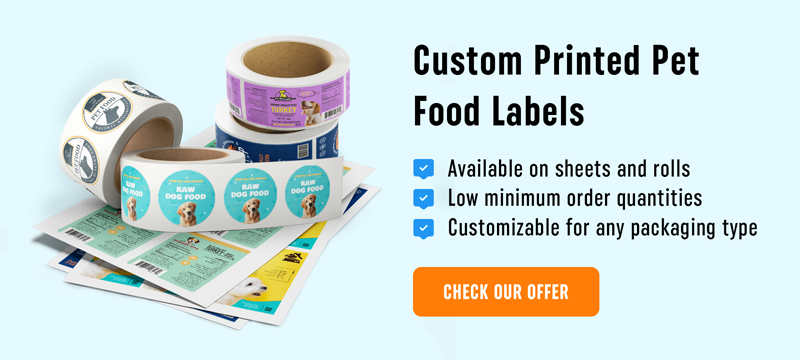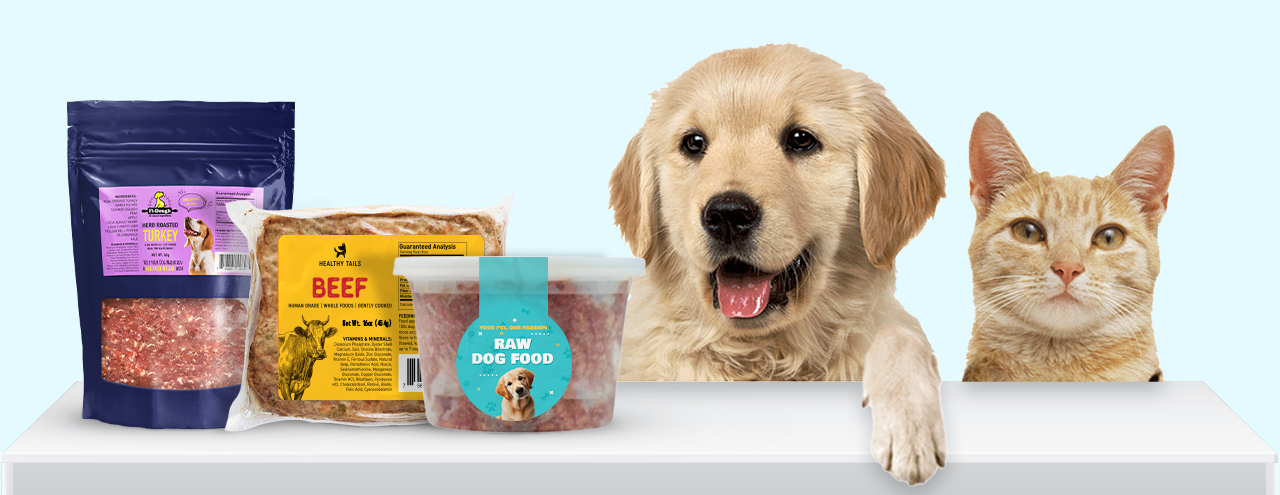People often care more about their pets’ nutrition and well being, than about their own. It’s no surprise that pet food business is a very lucrative industry. In line with that, the standards for pet food labels are very serious. Many pet food manufacturers have to take into consideration two levels of labeling regulations for their product: the federal regulations that are enforced by the FDA, and state regulations that are enforced in many states by the Association of American Feed Control Officials (AAFCO). They cover some more specific practices of pet food labeling, such as the information about guaranteed analysis, feeding directions, nutritional adequacy statement, etc.
What Are Mandatory FDA-Regulated Pet Food Labels?
The FDA requires that all pet food includes the following information on the label:
- Product name
- Net quantity statement
- Ingredient list
- Manufacturer’s name and address
You’d think creating a product name is a pretty straightforward business. However, there are very specific rules about which product names are allowed and which would get the manufacturer into trouble with the FDA.
You’ll notice that many pet food names include a specific ingredient, sometimes even two. This way the manufacturer wants to point out that their product is made up mostly of that ingredient(s): beef, tuna, chicken, fish, cheese, etc.
However, they are entitled to use that ingredient only if it comprises 95% (with water) or 70% (without water) of the whole product. Further, if the product name includes two ingredients in the title, they have to be positioned in the order of predominance by weight, that is, if the product contains more beef than broccoli, it should be called “Beef and Broccoli Cat Food,” and not “Broccoli and Beef Cat Food.”
If an ingredient makes up less than 95% (with water), but more than 25%, the product name needs to include a descriptive term “dinner,” as in the example: “Tuna Dinner for Cats.” If manufacturers want to use another ingredient in the “dinner” product name, it needs to comprise at least 3% of the product.
When it comes to the ingredients list, it’s important to note that the ingredients that are listed in the order of predominance by weight contain water. That is because they are weighted when already added in the formulation, with added water content. This fact can mislead consumers about the amount/weight of certain ingredients in the product. For example, a can of meat for pets can have less protein than a smaller portion of raw pet food, because canned meat will have high water content.
Which Parts of the Label Are Regulated By AAFCO?
Many states choose to conform to AAFCO regulations when it comes to pet food labeling.
AAFCO makes sure the following labels appear on pet food packaging and give valuable information to buyers: guaranteed analysis, nutritional adequacy statement, feeding directions, calorie statement and other label claims. Let’s see what’s what.
Guaranteed analysis label shows the minimum percentage of protein and fat in the pet food, as well as maximum percentage of fiber and moisture in the product. Many producers choose to give guarantees for other nutrients, such as some mineral components, taurine and magnesium, calcium, sodium, etc. As we already mentioned, the levels of nutrients greatly differ between canned and dry food, mostly because canned food contains a much larger percentage of moisture.
Another important label endorsed by AAFCO is the nutritional adequacy statement. Sometimes manufacturers are tempted to provide claims that are not quite accurate, in order to lure more customers. For example, they’ll use the words “100% nutritious” to describe a pet food product, which can be dangerous if the product does not provide all necessary nutrients for the pet.
However, pet food in states that use AAFCO’s nutritional adequacy statement will usually contain one of these two labels: “(Name of product) is formulated to meet the nutritional levels established by the AAFCO (Dog/Cat) Food Nutrient Profiles,” or “Animal feeding tests using AAFCO procedures substantiate that (name of product) provides complete and balanced nutrition.” If the product does not provide enough necessary nutrients, there should be the following label on the packaging: “This product is intended for intermittent or supplemental feeding only.”
Similarly, AAFCO also regulates the calorie statement, which is another important piece of information for pet owners. Calorie content can vary greatly depending on the type of food, whether it’s canned or dry, how much water and fiber is present in the product, etc.
Feeding directions usually provide information about the amount of food a pet should intake daily, and they vary depending on the pet’s breed, weight, environment etc.
Many other claims can be found on pet foods, for example: “no artificial flavors” (even though artificial flavors are generally not added to pet food), “natural” (even though there’s no definition for that term on food labels), “premium” or “gourmet” (even though they often don’t have any more quality ingredients than other pet food products), etc.
Both the FDA and AAFCO want to help pet owners be better informed about their pets’ nutrition, but pet food buyers should also take a very active role in studying the pet food products and their labels.
Choosing the Best Materials for Frozen Pet Food Labels
Since many of pet food products are meant to be kept in the freezer, the best solution for pet food labels are freezer grade stock and adhesive label materials.
Many non-freezer grade labels fall of the pet food packaging before the product’s been used or expired, which diminishes the buyers’ trust in the pet food company. The best way to prevent this is to follow the best manufacturing practices for quality frozen food labels.
Need High-Quality Labels for Your Frozen Pet Food Products?
Contact FreezerLabels.net today to get custom labels that withstand freezing conditions or check our full offer below.

Is Frozen Pet Food Safe and Nutritious?
There are many forms of food for pets: canned, dried, freeze-dried, raw, frozen raw, etc. You’ll commonly see the following statement on many pet food packaging: “product should be kept frozen until ready to use.” If you buy an already frozen pet food, you should keep it frozen until it’s time to feed the pet. If you are freezing raw, dry, wet pet food, the best advice for that is to freeze it right after purchasing, and keep it frozen until ready to use.
There is a rising trend of using raw food for pets, especially dogs and cats. Many dog owners wonder: can raw dog food be frozen? They wonder whether it is safe after the thawing process, and if it still as nutritious as raw, never-frozen food.
The main rule of freezing, just like with food for humans, is that it should not be frozen twice. Once defrosted, it should be used right away. Also, it is important to follow safe handling instructions on the packaging. Sometimes producers add information about how to safely defrost the product, and if you are not pressed for time, it is always safest to thaw food in the refrigerator.
Freezing can only help consumers keep a product longer. It allows pet food manufacturers to make their products preservative-free, which immediately makes the food healthier.
If you read the pet food label, and follow advice on how to safely handle, freeze and defrost the product, you can rest assured your pet’s nutrition will be well taken care of.

